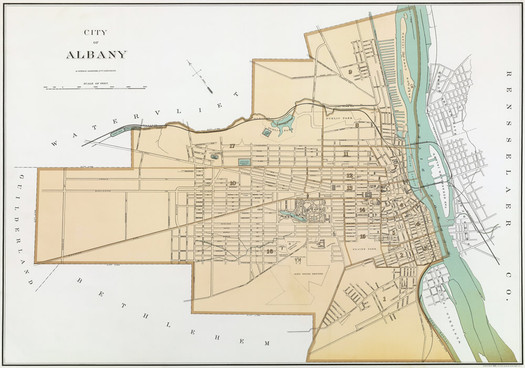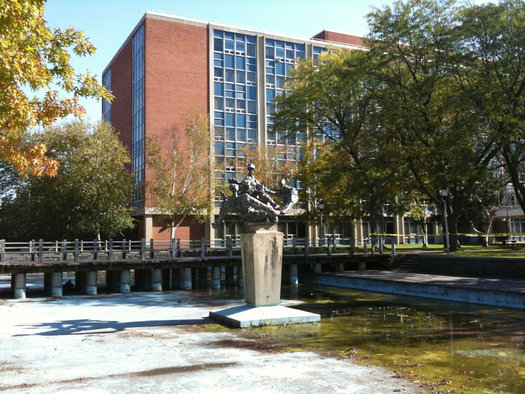That time -- not even that long ago -- that Albany annexed a chunk of Bethlehem

Was Bethlehem, is now Albany.
There was a bit of ripple this week when Albany mayor Kathy Sheehan mentioned the topic of annexation during a panel discussion about poverty and cities. From an article over at Capital:
"We could expand," Sheehan said. "States that have elastic cities where there's an ability annex do not have the same stratification that we see here in New York State. So there are states where you can grow your way out of this situation because you can expand your tax base by annexing. We can look at that, but we could also look at how we fundamentally fund our cities ... because cities still grow every day. The city of Albany doubles in population every day when people come here to work.
"We have to look at all levels at how we are funding our cities and have a conversation with those wealthier, surrounding suburban communities about what it is we need to do to address that inequity that we have," she said.
So this was a more a nod to the idea than actually raising it as a realistic option. (Update: Here's Sheehan emphasizing that point. [TWCN]) And that makes sense, because the idea that Albany could/would annex one of its surrounding suburbs seems... highly unlikely.
But. You might be surprised to find out that Albany has done just that in the past -- and it wasn't even that long ago (on the scale of Albany history). And the episode highlights why it would be so unlikely today.
Albany's shifting borders

The city of Albany in 1895. Here's a larger version via Wikipedia.
The city of Albany's borders have shifted a lot over its three-plus centuries, specifically between 1815 and 1967 when the city annexed -- and ceded -- land in areas such as Colonie, Watervliet, Guilderland, and Bethlehem.
The period between the 1930s and 1960s was especially active -- and contentious -- as the city and the town of Bethlehem pushed back and forth over chunks of land along the city's southern border. Albany had annexed the hamlets of Kenwood and Normansville in 1916 and Bethlehem officials were irked that the city kept nibbling away at the town's northern side. Albany successful grabbed a development between Krumkill Road and Whitehall Road called Golden Acres in the 1930s, but the town was able to turn away other city efforts over the next few decades.
Karlsfeld-Hurstville

Clip from The Knickerbocker News, September 10, 1964 via Fulton History newspaper database
Jump ahead to the 1960s. The city of Albany's borders look more or less like they do today -- except for a large chunk on the city's southwestern border, along Whitehall Road and New Scotland Road. This area -- actually two areas, called Karlsfeld and Hurstville -- includes the city's municipal golf course, which at the time was located in Bethlehem. (The city was paying taxes to the town on the property.)
Residents of this section of Bethlehem had apparently been feeling under-attended by the town for years and were looking to the city of Albany as a source of better services. From a 1964 Knickerbocker News article about an epic public meeting (5+ hours) about section wanting to switch sides:
Karlsfeld-Hurstville residents favoring annexation to Albany contended the city can supply: Water more economically than the town, a sewerage system now, which they say the town concedes it cannot do; tuition-free education for their children in Albany public schools, and generally, better municipal services, from fire and police protection to garbage collection.
"The Town of Bethlehem has offered too little too late and at a cost that is far too much," said Edwin R. Tymann of 16 Mountain View Avenue.
"Most of us folks out here feel a kinship to the City of Albany that he do not feel to the Town of Bethlehem," said Philip M. Willis of 27 Mountain View Avenue. "That's the best reason for annexation."
"I want a sewer system now, not one in 10, 15, or 20 years ... at a price which I am not able to pay," said Joseph E. Burkhart of 15 Wood Terrace.
"Hurstville-Karlsfeld has always been somewhat alien to the rest of Bethlehem," Mr. [Daniel] Halloran [member of the annexation committee] said. "Under the Suburban Town Law, it is conceivable that it might someday become a drain on the town economy as well."
Bethlehem wasn't ready to let the area go without a fight. And the annexation process ended up in the courts, including a state appellate tribunal and a decision by the state's highest court, before the matter was allowed to come to a public vote.
In June of 1967 residents went to the polls and voted in favor of annexation to the city of Albany, by a total of 244-113. And the section of the town -- -- roughly 1,000 acres (1.5 square miles) with a property value then of $2 million* -- officially became part of the city of Albany at noon on August 15, 1967.
(* Of course, in true Albany fashion, more than half the land was un-taxable, in part because it included multiple parcels owned by religious organizations.)
Thinking about this situation now

The Harriman State Office Campus in Albany.
The annexation of Hurstville-Karlsfeld is remarkable from today's perspective because it's an inverse of the situation that so often plays out now in Albany and many other cities. Here was a group of people clamoring to get into the city because of the promise of better services, a better school situation, and more favorable taxes. Those sorts of factors are the reasons many people now cite for leaving the city.
And that highlights one of the reasons why annexation is so unlikely a solution for the city today: How would Albany convince sections of Bethlehem or Guilderland or Colonie that they'd be better off in the city than their respective towns? It would be a steep uphill fight.
That's not say Albany and other cities shouldn't be exploring options for sharing the weight of some of their obligations with other municipalities in their regions. Albany hosts numerous, often tax-exempt, facilities that provide many jobs to people who live outside the city -- people who travel in every day to benefit at those spots and then drive back home to their suburban homes where they're paying property taxes to their town, not the city.
Of course, how to share that weight is a hard question. Many of the potential solutions that have surfaced other places -- like a commuter tax -- are just as much an unlikely option as annexation. So maybe the solution is something more along the lines of convincing large, untaxed institutions to make some sort of annual payment. (There's been some (unclear) movement on that front.) Or maybe it's a matter of using the state as the mechanism.
Whatever the solution, Albany needs the help. And asking its neighbors to help in some way, fiscally or otherwise -- especially when they benefit so much from being next to the city -- is not an unreasonable topic of discussion.
Hi there. Comments have been closed for this item. Still have something to say? Contact us.
Comments
"I want a sewer system now, not one in 10, 15, or 20 years ..."
Some FIFTY years later, Hartman Road, which is in the middle of this annexed Hurstville-Karlsfeld section, is still not on the sewer system. I don't know why this street was left out, but I've heard a present-day resident beef about it when he pays Albany taxes.
... said chrisck on Jan 15, 2015 at 1:04 PM | link
Very weird that this would come up on the same day that over on the "Albany...The Way It Was" FB page we're trying to precisely geolocate the old Kenwood Bridge on the "Bethlehem Turnpike." The article on plans to scrap it in 1942 notes that the bridge had originally been entirely within Bethlehem, but that the city line now ran through the middle of the Normanskill. That was probably the 1916 annexation that you noted.
... said Carl on Jan 15, 2015 at 1:51 PM | link
Where is the proof that there's no way for Albany to get back on solid fiscal ground?
Maybe the city can never be sustainable at current revenue levels, but I'd really like to see a study of what would have to be cut in order to move the city toward a balanced budget.
Before we talk about more money, let's discuss better management. Is anyone willing to make tough choices on spending? Not that I've noticed.
... said Rob on Jan 15, 2015 at 2:14 PM | link
I will NOT vote for her again. She can't even make sure the sidewalks are cleaned of snow and ice after a storm. I watched a woman in a wheel chair and several people with baby strollers having to maneuver in the road on Lark Street last night.
I fell on Washington Avenue out side of Key bank.
... said Cyril on Jan 15, 2015 at 4:08 PM | link
@Cyril - clearing of sidewalks is the property owner's responsibility. The city can issue warnings and can levy fines, as well as clearing the walk and billing the property owner after 48 hours.
... said Carl on Jan 15, 2015 at 4:36 PM | link
Very interesting! The original deed for my house (built in 1906, I believe) lists the address as Bethlehem. Makes sense to me now.
... said Silvia Meder Lilly on Jan 16, 2015 at 10:27 AM | link
You omit the other side.. in 1960, Mayor Corning sold off the airport and a huge tract of surrounding land to balance the budget. In 1967, a 64 acre track in Colonie was sold to balance the 1968 budget. https://www.flickr.com/photos/albanygroup/9330843798/in/set-72157634806098662
These were areas that held the greatest hope for economic development. The last sale was after Colonie Center was built.
... said Julie on Jan 16, 2015 at 11:47 AM | link
Oh and spousal unit asks if we can vote to revert back? I would in a heartbeat.. I live in the 1938 annexation area.
... said julie on Jan 16, 2015 at 12:27 PM | link
Julie- it appears the land that was sold was city-owned, but not part of the City, so a little different. The city could have made money leasing the land out, but it would not have been able to collect property tax on it without annexing it, which would be mostly likely not possible since it would have been completely surrounded by Colonie.
... said Blergh on Jan 16, 2015 at 1:47 PM | link
A cynical friend of mine not long ago said that Albany just needs gentrification. Push all the poor people out to South Colonie along Central Avenue in the west albany enclave. Arbor Hill was a wealthy neighborhood in the past and could be again with the architecture along Clinton Avenue. Then we'd have a tax base again.
... said Paul on Jan 16, 2015 at 5:28 PM | link